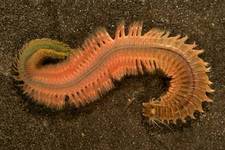The Hackensack River is slowly getting better in ways that most people never think of.
It’s not just more fish and more species of fish — or more birds, and more species of birds. It’s what’s happening in the mud on the river’s bottom.
Today, the New Jersey Meadowlands Commission‘s scientific arm is announcing some encouraging news about the health of those little mud dwellers.
Research by the Meadowlands Environmental Research Institute shows that the snails, worms and other tiny organisms that live on t he bottom of the river are making significant gains in both numbers and biodiversity.
he bottom of the river are making significant gains in both numbers and biodiversity.
(In the photo at left, researchers are gathering mud samples from the river bottom with a giant scoop. The creature pictured here, meanwhile is a Nereis succinea — or clam worm.)
Click "Continue reading…" to read more.
MERI conducted surveys in 1987 and 2002 to see how well these organisms –- known as benthic macroinvertebrates –- were doing.
The results, to be formally presented later this year, are mostly encouraging.
The study indicates that significant improvements have occurred in the mud-dwelling populations in the 15 years since the original survey was conducted. (Dr. Francisco Artigas of MERI, who gave today’s press presentation, is pictured here.)
They eat the detritus and organic matter that settles on the bottom of the river and its tributaries, in the process recycling nutrients and helping oxygenate the mud at the bottom of the river.
(Pictur ed here, Macoma balthica –– a small saltwater clam.)
ed here, Macoma balthica –– a small saltwater clam.)
The survey involved some extremely labor-intensive work that included manually sifting and sorting through three sets of mud samples at 26 locations for each of all four seasons – or 312 samples for each of the surveys. In some cases, a magnifying glass was needed to find these organisms.
Research by NJMC in collaboration with the New Jersey Audubon Society documented that more than 60 percent of the state’s endangered or threatened bird species are in the Meadowlands at some point during the year.
Another MERI study found that fish populations in the Meadowlands are making a comeback as well.


Spring, sweaters and sweater tenderness carnival. Whether it is knitting coarse line with a lazy breath, or gentle, pleasant woven fine wool line, are usually strong,